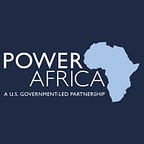Powering Nigeria — How U.S. Businesses are Finding New Opportunities Through the U.S. Electrify Africa Act
Every day in Nigeria as much gas is flared (just burned into the air and not used for any productive purpose) as is used for power generation. It’s flared because the market has not found a productive use for it, and it’s a by-product of the oil industry. But if the flared gas could be captured and used, it could provide electricity for households and industry.
Nigeria desperately needs power. It’s a country of 190 million people that currently generates as much power as Maine, with its 1.3 million residents. U.S. companies, and U.S. technology that can be exported to Nigeria, hold the promise to help Nigerians use flared gas to power their economy and to light millions of homes. And in the process, we can create more jobs in the U.S.
In 2016, the U.S. Congress unanimously passed the Electrify Africa Act, an effort that will bring 20,000 MW of new power to sub-Saharan Africa by 2020. The Act, being implemented by the U.S. government’s 12-agency Power Africa team, has high hopes for power generation in countries like Nigeria. The stability and economic growth that will come from a consistent power supply in Nigeria will increase security in west Africa, as well as in the U.S.
The onshore flare sites in Nigeria sit among communities in the Niger Delta. Many of these communities have felt left out of the riches of the oil and gas industry and don’t even have basic access to electricity. This resentment has led to extreme violence and vandalism. Militant groups like the “Niger Delta Avengers” have blown up pipelines, crippling Nigeria’s economy because there is not enough gas available to supply power generation plants.
Power Africa is working with the Government of Nigeria to figure out how to generate power directly at these sites. There are roughly 100 onshore flaring locations, but all produce relatively small quantities of gas. It would be more than enough to power a small industry or power station, but fossil fuel technology is typically designed for large centralized facilities. Wouldn’t it be nice if there was a solution that was right-sized for smaller volumes of gas?
That’s where U.S. companies come in. The U.S. has been revolutionizing the gas sector. Since hydraulic fracturing (fracking) paired with horizontal drilling became economically viable almost 20 years ago, the U.S. has rapidly developed shale gas, changing the energy landscape at home and internationally. The glut of gas has reduced prices and emissions for U.S. power generation. The opening of Sabine Pass as an export facility in Louisiana in February 2016 brought these prices to the world market. Over the past ten years, gas prices decoupled from oil prices, long-term contracts gave way to spot pricing, and flexibility became the name of the game.
Cheap gas hasn’t just changed the economics, it’s changed the technology. Fracking is often done at small or marginal resources that are quickly exhausted. Equipment needs to be modular and moveable so it can be transported from site to site. Traditional pipelines don’t always make sense in remote areas with small, decentralized gas wells. Micro-processing and “virtual pipelines” made up of Compressed Natural Gas (CNG) trucks make much more sense.
U.S. entrepreneurs have been seizing this opportunity, developing the technologies and business models that fit these sites. And several smart ones on the U.S. Gulf Coast have realized that the bayous of Louisiana aren’t that different from the mangroves of the Niger Delta.
With every problem, there’s an opportunity, and Power Africa is flexing its muscles, bringing U.S. innovation and acumen to solve a development challenge that affects us all. Following a U.S. Agency for International Development (USAID) study on flare sites that helped quantify the problem as well as the opportunity, the U.S. Trade and Development Agency (USTDA) brought a delegation of Nigerian officials and private business owners from the gas sector on a reverse trade mission (RTM) to Houston and New Orleans. RTMs are designed to expose foreign companies and governments to the quality products designed and built in the U.S. The delegation met with companies that provide on-site processing and power generation solutions, suppliers that provide virtual pipelines through compression paired with trucking, and businesses that sell the necessary components, such as floating concrete platforms that are designed for “swampy” conditions like the Delta.
Power Africa brought Nigerians to the U.S. to do business. Questions focused on delivered cost, exact sizing and specs of equipment, and output levels. The most motivated U.S. companies aggressively pitched how they could put together components that would fit the Nigerian market. Both sides will need to hammer out details, but there’s no question there are deals to be made.
Infrastructure development continues to be a slow business and Power Africa will need to ramp up its work to meet the Electrify Africa targets by 2020. If successful, the end result is good for Nigeria, good for our own security, and especially good for the U.S. companies that can export their innovative equipment to a new market, creating new jobs in the U.S.
Dr. Kate Steel is the Energy Director for Power Africa at USAID and has worked for fifteen years on energy access in emerging markets.
